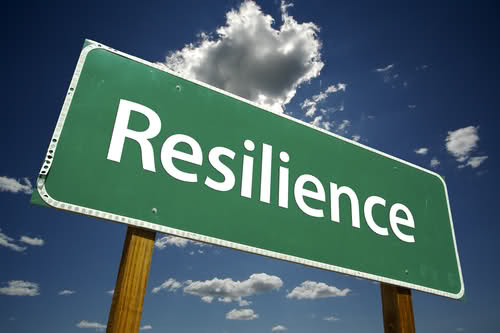By Clinical Psychology Registrar, Dr James Kirby
We all face challenging events from time to time. For example, it could be something like not getting the grade we wanted on a project at school or university, losing at a team sport, or receiving some kind of bad news. When moments like these happen it can make some people feel annoyed, frustrated, sad, or even angry. As a result, it can be difficult for some people to continue doing the things that are important to them. In these situations what can be useful is resilience.
But what is resilience?
Resilience is how we adapt and cope to life’s challenges. Resilience can help you ‘bounce back’ when dealing with difficult situations and stress. If we are resilient it means that we can lessen the impact of a bad event and improve our chances of recovery. Importantly, resilience is not about avoiding bad things, or being lucky, or not letting things get to you. Rather resilience is about you taking actions to help adapt to the difficulty you are facing. And the difficulties could range from school things, to work problems, to problems with friends, and health issues.
“It is not the strongest of the species that survives, nor the most intelligent, but the one most responsive to change.”
Charles Darwin
Step 1: Early Warning Signs
The first thing to do in an attempt to build your resilience is to notice when you are feeling low in energy and that you are not coping. We sometimes refer to this as your ‘early warning signs’. Everyone will have different types of early warning signs, some people notice that they aren’t sleeping very well, others will notice physical symptoms such as having a sore throat, or feeling tired, or having a few aches and pains. Others will notice psychological signs, such as they are starting to get cranky with others or get frustrated with themselves. For some people the first time they notice their early warning signs is when someone asks them, “Are you OK, you don’t seem yourself?”. When you have low levels of resilience try to see how it impacts your thoughts, feelings, actions, and relationships with others. The important step here is to try and notice what your early warning signs are, because once you are aware of them you can start to do something to boost up and improve your levels of resilience.
Step 2: Meaningful Action
Once you have noticed your early warning signs, the second step is to do something about it. This requires action, and not just any sort of action, meaningful action. Meaningful action is part of a meaningful life, and a meaningful life increases resilience. Meaningful actions are ones that are consistent with our values as a person. Values are a standard or a principle that we find important, they are what we believe in. Values are the ways we want to live our lives. So your values might be, being a good friend, or being healthy, or being a good brother or sister. We can have values in all different kinds of domains such as with family, social relationships, career, home environment, health, spirituality, community service, and leisure. Values are different to goals, as goals have end points, but values are forever ongoing. For example, you might find the value of being healthy very important to you, so a goal might be to exercise 15-20 minutes each day. When we have low levels of resilience we tend to stop living in the direction of our values, so it is important to take stock of what aspects of your life you value, and what meaningful actions you can take so that you are living your life in accordance with them.
Step 3: Mindfulness
Mindfulness is about being in the present moment. To appreciate the richness and fullness of life, you have to be in the NOW while it is happening. Each moment is here to be lived. Being caught up with the past or the future means that you may not see opportunities that are in the present moment. Being in the present moment may mean that you become aware of unpleasant or unwanted experiences (e.g., thoughts, feelings). Being open to any experience, whether pleasant or unpleasant, is an important component of resilience as it provides perspective and a connection with reality that allows you to take effective action. One way of trying to use mindfulness is to do mindfulness of sound. This involves the following 5-minute exercise:
- Find a comfortable position. If you are sitting, be sure you have your feet flat on the floor, back straight, shoulders loose. Make your legs are uncrossed.
- Make it your intention for the next few minutes to purely and simply be present, here and now – and to notice what is happening.
- Focus on what you can hear. You may like to close your eyes or fix them on a non-distracting spot. Notice a sound. Notice the quality of the sound, the pitch, volume, and fluctuations. Is it continuous or does it come and go?
- You might notice yourself being distracted whilst doing this exercise. Your attention can wander, and you may start thinking about other things. As soon as you realise this has happened, notice what distracted you, and gently bring your attention back to the sounds.
The idea of mindfulness of the sound is to bring us to present moment awareness. When we are in the present moment we are more open to experience, which then allows you to be able to decide how you would like to respond rather than responding automatically. Mindfulness also allows you the opportunity to notice your early warning signs. You could do the same mindfulness exercise for sight. An easy way to check in with your mindfulness each day is to try the strategy Five Senses.
- Pause for a moment.
- Notice one thing you can see.
- Notice one thing you can hear.
- Notice one thing you can physically feel.
- Notice one thing you can smell.
- Notice one thing you can taste.
Step 4: Thoughts
Another way in which you can build your resilience is to notice your thoughts. Often when we have thoughts we do not want, we try not to think about it. So we distract ourselves, or tell ourselves not to think about it. Although this can feel like it is helpful it sometimes does not work as well as what we would like. For example if I said, “Try not to think of a banana. Can you do it?” While you are trying not to think of it, you might have a banana in mind, or maybe even thought of a banana split, or maybe the colour yellow. When we try to control our thoughts like this it can sometimes make it worse. The important point here is having thoughts is OK, our minds are thought producing machines. The key is not whether we have the thought, but it is how we react to that thought. Often people can fall into traps where they see their thought as being true and very important. As a result the thoughts can be taken literally and we buy into the thought and we believe in it 100%. When we do this we tend to become inflexible and our thoughts become rigid and fixed. When this happens we can start to lose our ability to be resilient, as being resilient is about being adaptive and responsive.
An alternative to trying to control our thoughts is to just notice that we have all different kinds of thoughts. And we can choose how we would like to respond to them. Remember thoughts are just words. Thoughts are what you have, not what you are. That means you can stand back from a thought, and see the thought, and then choose how you would like to respond to it. One way to help give you space or distance from your thoughts is to say to yourself, “I notice I am having the thought…..” When we put this label before our thought it can help provide distance between the thought being who you are, and rather it is just something you are having. As a result you can choose what you do next.
Take Home Messages
We have just scratched the surface in this blog on ways to help build your resilience, and below is some simple take home messages you can use to help build your resilience.
- Notice your early warning signs, they could be physical or psychological.
- Take time to consider what values are important to you.
- Consider some meaningful actions you could make that allow you to work towards your values.
- Try mindfulness, either mindfulness of sound or try the same exercise but try it with your sight.
- Try using the technique, “I notice I am having the thought…..” to help build space between you and your thoughts.
Further Information
For more information on James and the team at Psychology Consultants, visit www.psychologyconsultants.com.au
If you would like further information about how to build your resilience you can consider seeking professional help by contacting a professional, such as a psychologist or talk to your doctor about what you can do.
Author- James N. Kirby, PhD.


You must be logged in to post a comment.